Cherry Audio Synthesizer Expander Module (SEM): What is it?
MacOS: 10.13 or above
Windows: 7 or above
View at Cherry Audio
When Tom Oberheim launched his company in 1969, he probably didn’t realise the influence his designs would have. His initial products were based around effects processing, followed swiftly by one of the first digital sequencers. But it was the appearance of the Synthesizer Expander Module (SEM) in 1974 that captured the imagination of musicians and synthesists, which continues to this day.
The SEM was (and is) a monophonic synth voice, replete with two oscillators, variable-state filter, envelopes and LFOs. It was designed to act as a voice-partner for the Oberheim DS-2 sequencer, before Tom had the idea of placing two, four and even eight SEMs in a keyboard construct, creating the 2-voice, 4-voice and 8-voice synthesisers. After several years in the production wilderness, SEMs were brought back to life, with a limited number of hand-built reissues being manufactured during the years after 2009. With the exorbitant cost of both the vintage and reissued models, the appeal of software has never been greater, especially at a zero price point.
Cherry Audio’s reimagining of the SEM begins with its usual attention to detail, through hi-res graphics; it looks absolutely stunning. You can see the shadow of the casting holes on the fascia, with the outline of the stickers above the jack points on the rear, while the end-cheeks glisten as though they’re catching the light in the room. It looks three-dimensional and we kept having to tell ourselves that it wasn’t protruding from the screen. In a slight change from the company’s norm, there is no Focus mode; this appears on other Cherry Audio products, as an elegant method of zooming in on the GUI’s panel, but with a generous resizable plugin window, it doesn’t feel like it’s required.

Cherry Audio Synthesizer Expander Module (SEM): Performance and verdict
So with a big tick on the graphics front, how does it sound? Well, we thought we’d put it through its paces against a reissued Oberheim SEM from 2009, to see how it compared.

• GForce Software Oberheim SEM
GForce’s take on the SEM is another high quality software iteration, with a host of additional functions.
• Arturia SEM V
One of the first of the SEM software reincarnations: worthy, but feels overpriced in the current lineup.
The simple answer is, amazingly well. It’s going to be very difficult for any software to compete with any aging analogue device, as the circuit degradation alone will likely add colour to the sound, but while the original SEM packed just slightly more punch and depth (and we’re being hyper picky), the Cherry Audio model exhibits a production-ready status, with a sound which is incredibly authentic. This extends to the positioning of the potentiometers on the fascia, where the software even pulled off some remarkable mimicry.
What we overwhelmingly love about Cherry Audio’s SEM, apart from the lack of price, is its unambiguous simplicity. It maintains the signal/modulation switching and odd quirks of the original, along with the classic variable-state filter, which sweeps from low to hi-pass modes, or can be placed in band-pass mode. The basic modulation of pitch and pulse-width remains, but it’s the versatility and wispiness of the filter, that totally endears us. Place the filter through the onboard stereo Phasor, and it sounds utterly stunning, although you also have the option of onboard delay and a Unison mode with detune, should you be wanting to widen the oscillator texture upfront.

Modern tendencies
Let’s be honest, you don’t need to persuade synth-heads to download a freebie, although the Cherry SEM would be a bargain even if it were placed around its usual competitive price points.
The Cherry SEM would be a bargain even if it were to be placed around its usual competitive price points
Placing this to one side, it sounds unbelievably good, even alongside hardware, and provides the added convenience of saving patches. Cherry Audio has supplied a handful of great presets to get you going, but as this is a quirky-but-simple mono-beast, which sounds totally Oberheim, you may well eventually find it difficult not to get twitchy with your own editing and automation.
MusicRadar verdict: As a versatile and authentic software incarnation of an Oberheim classic, it wins hands down both visually and sonically. The fact that it’s free makes it a no-brainer.
Cherry Audio Synthesizer Expander Module (SEM): Hands-on demos
Cherry Audio
musictechtuition
CatSynth TV
Elektronick Musick
Cherry Audio Synthesizer Expander Module (SEM): Specifications
- macOS 10.13 or above. macOS 13 Ventura supported. 64-bit required. Native Apple M1 or greater processor support, including Ultra. Hard disk space: 106 MB. 3.4GHz Quad-Core or M1 CPU with 8GB of RAM recommended.
- Windows 7 or above (including Windows 11), 64-bit required. 3.4 GHz Quad-Core computer with 8GB of RAM recommended. Hard disk space: 106 MB.
- CONTACT: Cherry Audio

